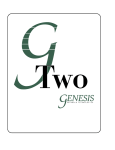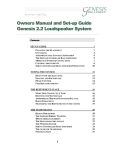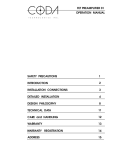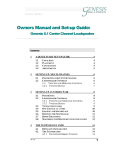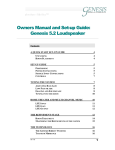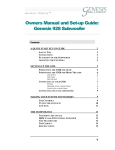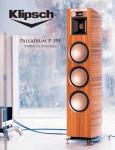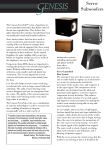Download Genesis Advanced Technologies 1.1 User's Manual
Transcript
~ÄëçäìíÉ=ÑáÇÉäáíó Owners Manual and Set-up Guide: Genesis 1.1 Loudspeaker System Contents 1 2 3 4 Ver 2.0 SET-UP GUIDE 5 1.1 UNPACKING 1.2 PLACEMENT OF THE GENESIS 1.1 LOUDSPEAKER 1.3 WOOFER CONNECTIONS 1.4 SERVO-CONTROLLED BASS AMPLIFIER CONNECTIONS 1.5 CROSSOVER CONNECTIONS 1.6 REMOTE CONTROL 1.7 CROSSOVER CONTROLS 5 8 9 10 11 12 13 TUNING THE SYSTEM 13 2.1 BEGIN WITH THE BASS LEVEL 2.2 IMAGING AND SOUNDSTAGE 2.3 PHASE CONTROL 2.4 FURTHER ADJUSTMENTS 14 15 16 17 THE REFINEMENT STAGE 17 3.1 3.2 3.3 3.4 3.5 3.6 17 17 18 18 19 20 RUNNING-IN THE SYSTEM MAKE ONE CHANGE AT A TIME DEFINING THE SOUNDSTAGE APPROPRIATE MID-BASS BALANCE ROOM TREATMENT MASTERING THE REFINEMENTS OF THE SYSTEM THE TECHNOLOGY 21 4.1 4.2 4.3 4.4 4.5 4.6 4.7 4.8 4.9 21 22 23 23 24 25 25 26 26 DESIGN PHILOSOPHY: DIPOLAR LINE SOURCE THE GENESIS RIBBON TWEETER 75-INCH MIDRANGE RIBBON THE SERVO-BASS ADVANTAGE THE WOOFER TOWER SERVO-CONTROLLED AMPLIFIER/CROSSOVER THE CROSSOVER CORIAN™ BAFFLE, WINGS AND BASES SUMMARY 1 ~ÄëçäìíÉ=ÑáÇÉäáíó Details: Here are the serial numbers of your Genesis 1.1 System. Please keep this document safe for future reference. Serial Numbers Mid/Tweeter Panels : ________________ Woofer Towers : ________________ Bass Amplifiers : ________________ Dealer: Date: . Genesis Advanced Technologies 654 S Lucile St Seattle, WA 98108 USA Tel +1 206 762 8383 Fax +1 206 762 8389 www.genesisloudspeakers.com Ver 2.0 2 ~ÄëçäìíÉ=ÑáÇÉäáíó A Message from Genesis Congratulations! You are now the owner of the finest loudspeaker system in the world. The Genesis Advanced Technologies 1.1 Loudspeaker System is the embodiment of our philosophy of “absolute fidelity ” – the ability to reproduce any musical event faithfully, with no compromise, in your home. With its vast abilities, the Genesis 1.1 is also able to deliver sound as the filmmaker intended in home theater applications. The Genesis 1.1 is commissioned for the most discerning music lovers in the world. Every system is custom made and unique. It is the state-of-the-art in transducer technology and craftsmanship. A Short History: In June 1979, Mr. Arnie Nudell, the founder of Infinity Systems and Genesis, headed a small team at Infinity that conceived and created the remarkable Infinity Reference Standard (IRS). This soon came to be known as the world’s ultimate reference system for the reproduction of music. Fourteen years later in June 1993, Nudell, in collaboration with Paul McGowan, introduced to the world the Genesis 1 – a new benchmark for the reference loudspeaker system. The current Genesis 1.1 embodies over 20 years of evolution and revolution in loudspeaker design. It is the current ultimate reference for the reproduction of music. Whereas many other products might excel in one or more key areas, the Genesis 1.1 excels in every important aspect of sound reproduction: Spectral Coherence: The sound must be seamless, as if the lowest bass frequencies were cut from the same cloth as the highest frequencies. Harmonic Structure: All instruments must be readily identifiable by their harmonic content. There must be a uniformly consistent energy vs. frequency ratio throughout the entire audio spectrum with uniformly low distortion in order for this to be achieved. Macro Dynamic Capability: Sometimes characterized as “dynamic range”, macro-dynamics can be best defined in musical terms – from mezzo forte (mf or medium-loud), to triple forte (fff or very loud). Ver 2.0 3 ~ÄëçäìíÉ=ÑáÇÉäáíó Micro Dynamic Capability: This describes the ability of a system to resolve the lowest level material with as much articulation and imaging as it does at the louder levels. The most difficult areas for loudspeaker systems to reproduce well are the extremes, i.e. the micro-dynamics from ppp to p (pianissimo to piano), and the last part of the macrodynamics f to fff (forte to triple forte). Imaging and Soundstaging: A reference system must be able to recreate a deep, tall and wide soundstage with accurate imaging when reproducing recordings that contain such information. The effect is that of being able to clearly distinguish the specific locations (left/right, forward/back, height) at which the instruments are playing, and to be able to hear their performance from the perspective of the venue in which it was recorded. These concepts can be understood in a basic sense by examining the temporal coherence of a loudspeaker system. If each frequency of the audio spectrum arrives at the listener at the same time, spatial cues emanating from a performance are reproduced, i.e. sound waves bounced from the walls, floor and ceiling of the venue, attenuated in amplitude and displaced in time, can be resolved in space by two stereo channels. If a reference system can slice time “thinly enough”, and have excellent low-level resolving power, one can experience many such bounces off surfaces; all displaced correctly in time, ultimately defining the soundstage. Low Harmonic and Intermodulation Distortion: The greatest sound pressure peaks should create almost no distortion whatever. Many loudspeakers begin to experience signal compression at loud levels. When this happens, music becomes distorted as sounds compress. Reference systems cannot exhibit these symptoms. Just as live music sounds relaxed at the loudest levels, so must the reference system. Please read this Owners Manual and Set-up Guide to get the maximum enjoyment out of your purchase. Also, if you have access to the internet, please check back at our website often. The address is www.genesisloudspeakers.com. We will post the latest updates, tips & tricks and support for our customers. Ver 2.0 4 ~ÄëçäìíÉ=ÑáÇÉäáíó 1 Set-up Guide Now that you have your new Genesis 1.1 loudspeaker system, we realize that you can’t wait to hook it up and start playing! However, this is a big, complex system. There is no “quick” set-up. You will need at least three immensely strong people. Be prepared to allocate 5 to 8 hours to the initial unpacking, set-up and configuration. Mentally condition yourself for hard, manual work that must also be done carefully and precisely so as not to hurt your precious new acquisition. 1.1 Unpacking The Genesis 1.1 system is packed in eight (8) wooden shipping crates and four (4) cardboard boxes. There are two crates containing a woofer tower each, two midrange/tweeter wing-panel crates containing two wings per crate, two crates each containing the midrange ribbon and tweeters mounted on a Corian™ panel, a crate with the two midrange/tweeter wing bases, and another one with the two woofer tower bases. There will also be a box containing two crossover boxes, two boxes each holding a 6-channel servocontrolled bass amplifier, and a box containing all the supplied connecting cables. To remove the contents of all the crates, you will need at least three immensely strong people – the Genesis 1.1 loudspeaker system weighs a total of 2,640 lbs (1,200kg) – to move the various parts of the speakers around. We cannot be held liable for damage to either the speakers or your backs during unpacking and setting up. First, determine where you will be placing the speakers. They are extremely heavy, so some forward planning will come in handy. Depending on the surface they are set on, you may find that the speakers are impossible to shift after setting up. Please see the section on placement and carefully mark up the places where you will set the four columns. Start by un-boxing the woofer tower and wing bases. These are the small, flat wooden the crates. Unscrew the plywood top and remove. You will want to use a fully-recharged mechanical screwdriver for this as there are many, many long tightly inserted screws to be removed. Ver 2.0 5 ~ÄëçäìíÉ=ÑáÇÉäáíó Undo the lag bolts that hold the bases to the crate. Remove the bases one at a time and set them down where the woofer towers and wings will go. Verify that the positions are accurately aligned as it may be impossible to move them later. Next, remove the woofer towers from their shipping crates. These are the largest of the wooden crates. Position the crate near where you have put the woofer tower bases. You do not want to move the woofer tower very far once it is out of the crate. Either woofer tower can be used on the left or the right, so just pick one. First, remove the screws holding the top lid down and open the top of the crate. Remove the woofer grill cover and put aside safely. You may be surprised to see that the woofer tower is not wrapped in anything. This is to allow safe handling of the tower. If there is anything covering the veneer, it may be difficult to pick up this immensely heavy tower. The covering may tear, causing you to drop the tower. The soft foam cushioning is sufficient to ensure that the veneer finish is not marked. Next, remove the screws holding one side of the crate together. The woofer tower is then exposed and you can now lift the tower out the front of the opened crate. It may be easier if you dismantle all four sides of the crate if you do not have two immensely strong people capable of lifting the woofer tower by themselves. With the sides removed, four people can lift the tower out of the crate and onto its base. Determine which side is the top, and which the bottom. The bottom of the woofer is covered with soft felt, and the top is covered with veneer. Pick up the woofer tower, place the bottom on the base and stand the tower up. Set up the other woofer tower in the same way. You should flatten Ver 2.0 6 ~ÄëçäìíÉ=ÑáÇÉäáíó all crates and store them safely, in case you need to move these speakers some time in the future. Next, set up the midrange/tweeter wings. The wings are marked left and right, so set them up on the correct side. First locate the crate containing the left wings, and locate the corresponding Corian panel. The left Corian panel will have the column of tweeters to the right of the midrange ribbon. Unscrew the top of crates and remove the lids. First, remove the Corian panel with the tweeters and midrange and insert it into the center part of the base. Have someone hold the panel in place until the wings are put in place. The wings hold the panel up, and if the panel tilts too far front or back, the bottom might break off. Then, while someone else holds the panel vertical, place one of the veneer/mdf wings into the slot beside the panel. Once both wings are in place, screw the three parts together. Make sure that the tweeters are on the inside – ie. the row of tweeters are closer together than the midrange ribbons. Insert all 12 screws provided (with the washers) from the back through the holes in the wings into the inserts on the Corian panel. Finger-tighten the screws, taking care to seat the screws properly into the brass inserts. You may have to move the panel forwards and backwards slowly to align all the screws properly. Once all 12 screws are in, you can then tighten them to make the surface of the wings flush with the Corian panel. Do not over-tighten. The screws are just used to hold the wings and panel vertically in place. The curve of the wings provides most of the structural strength. Ver 2.0 7 ~ÄëçäìíÉ=ÑáÇÉäáíó 1.2 Placement of the Genesis 1.1 Loudspeaker The G1.1 requires a large room in order to give the speaker ample space from the walls so that it can perform at its best. A typical room size is 29 ft x 48 ft with 12 ft ceilings. A good starting position for the midrange/tweeter panels is 15 feet into the room as measured from the front wall (the wall behind the speakers which you look at as you are seated listening to the speakers) to the face of the speakers. You will want to sit 18 feet away as measured from the face of the speakers to the ears, and have approximately 15 feet (if available) behind you to the rear wall. Place the column of tweeters on the inside, and position the mid/tweeter panels so that the centers of the tweeters are 6 feet 10 inches apart. Next, position the woofer towers just to the outside of, and behind the mid/tweeter wings. Having the woofers diagonally six feet behind the midrange/tweeters work well. Placing the woofer towers asymmetric in the room results in a smoother bass response than if the woofers are symmetric. If you have a much more space and a wider room, the woofer towers can be also be positioned outside the mid/tweeter wings in an arc such that the center of the woofer cone and the tweeters are equidistant from the listeners. Typical room placement: Place speakers and listeners about 1/3 of the way into the room Tweeters 6’ to 8’ 1/3 or 20% Ver 2.0 1/3 or 20% 8 ~ÄëçäìíÉ=ÑáÇÉäáíó For some rooms, there may not be enough space and you will have to adjust as you see fit. In a smaller room, the speakers can be just 20% of the way into the room, and the listening position can then be 20% from the rear wall. (see the diagram above). If you have to sit less than 10 feet in front of the speakers, you have too small a room to accommodate the Genesis 1.1’s. 1.3 Woofer Connections Included with your Genesis 1.1 is a set of four large cables (with 3 channels each) used to connect the woofers. Each end of the cable is clearly marked, "amplifier" or "speaker" in red or white lettering. Use the set with red lettering for the right channel and white lettering for the left channel. Connect the appropriate ends to your Genesis Servo-controlled Bass amplifiers, and the rear of the woofer towers. It does not matter which connector is attached to which woofer as long as the left/right channels and cable direction are correct. For interest and reference, the connectors are numbered 1 thru 6 from left to right and top to bottom. Woofer number 1 being the top woofer, and woofer number 6 being the bottom woofer. When you connect the woofer tower outputs pay close attention to the way the connector works. The connector is a Neutrik™ Speakon™, it only goes in one way. You cannot put it in wrong, but you can fail to put it in all the way. Push the plug in, and twist it clockwise until the lock clicks. At the amplifier end of the cables, you will notice that there are “flying leads” coming out of the Neutriks all terminating in a little silver jack per cable. These are grounding jacks for the internal shield of the cables. These can be plugged into a termination female jack that is attached to the chassis of your amplifier. This is necessary in a high-static environment, or if there is Ver 2.0 9 ~ÄëçäìíÉ=ÑáÇÉäáíó significant hum being induced from electromagnetic radiation nearby. Otherwise, the ground jack can just be left unplugged. 1.4 Servo-controlled Bass Amplifier Connections The way that the Servo Controlled Bass (SCB) amplifier is connected to the rest of your system will largely determine the coherency of the bass to the midrange. However, no one method will work with all systems. The first big problem is that no power amplifier is “straight wire with gain”. The second problem is that interconnects and speaker cables are not perfect conductors. Hence, the Genesis 1.1 provides for two different methods of connection. 1) Each SCB amp has two input connectors, unbalanced RCA and balanced XLR. Either connection can be used but not both. This is the simplest way, to connect either the RCA or XLR input of the SCB amplifier to the output of your preamplifier. Use the same quality interconnect as you would for the main pre-amplifier to power amplifier interface. Bass is the foundation of music, and it may be difficult to integrate the bass to the midrange if there is a significant quality difference in the interconnection. If your preamplifier has only one set of outputs, you may have to invest in a good-quality Y-connector (either RCA or XLR), or commission a special Y-cable from your preferred interconnect provider. However, if your preamplifier has two sets of outputs, use one for driving the power amplifier that will drive the midrange/ tweeter and use the other output for the SCB amplifier. A problem with this method is that if the power amplifier used shifts phase significantly between its input and output (it may be phase coherent at its output), the midrange/tweeters may be out of phase with the woofers. 2) Ver 2.0 Alternatively, a cable (the Servo-Bass Interconnect) is provided that will enable the high-level output of the midrange/tweeter power amplifier to drive the SCB amplifier. This has a Neutrik XLR connector at one end, and bare wire at the other end. Within the Neutrik connector is a balancing and attenuation circuit that allows this connection to work with most (but not all) power amplifiers. 10 ~ÄëçäìíÉ=ÑáÇÉäáíó The preferred connection is to attach the bare wire on the Servo-Bass Interconnect to the midrange INPUT binding posts on the crossover box. This way, the Servo-Bass amplifier will “see” the same musical signal as the midrange/tweeter crossover, resulting in the most coherent crossover between the upper bass and lower midrange. We prefer the second method. This will allow everything in the chain up to the Genesis 1.1 crossover box (including all electronics and cables) to be taken into account. However, there are some systems that do not allow this. Some power amplifiers have BOTH positive and negative outputs at a significant potential above ground. Examples include some Class D designs. Other power amplifiers are significantly deficient in the bass, like single-ended triode designs. In both these cases, connecting the servo-bass amplifier to the preamp is the lesser of two evils. 1.5 Crossover Connections The cross-over boxes have three pairs of input and output connectors each. They are (from left to right) front tweeters, midrange and rear tweeters. The top row of connectors are the inputs and the bottom row are the outputs. These high quality binding posts from Cardas will accept either banana plugs or spade connectors. The crossovers are designed in three electrically separated parts so that the G1.1 can be tri-amplified with identical amplifiers. Do NOT use a lowpowered SET amplifier for the tweeters, and a high-powered solid-state amplifier for the midrange. You will ruin the spectral and phase coherency of the G1.1. A pair of jumpers with banana plugs at one end and spade connectors at the other end are provided to get you started if you only have a single channel of amplification. In that case, use your speaker wires to connect to the midrange input (the middle) and the jumpers to connect to the front and rear tweeters. With two channels of amplification, run one channel on the midrange, and the other channel on the front tweeters. Then Ver 2.0 11 ~ÄëçäìíÉ=ÑáÇÉäáíó use the supplied jumpers to connect the rear tweeters either to the midrange or the front tweeters. Depending on the amplifier used, one or the other will sound better. These jumpers are made using the same internal wire connect the drivers of the Genesis 1.1. However, you should also try using jumpers made of the same wire as you use for your speaker cables. For example, if your speaker cables are Cardas Golden Reference, then get the same for your jumpers. Next, the crossover box should be hooked up to the midrange/tweeter wings. From left to right, match the cross-over box connectors to the mid-panel connectors. Again, a set of jumpers is provided to help you get started. These are made of the Genesis internal hook-up wire, and are high quality OFC conductors with Kimber™ banana plugs. You could also try having jumpers made of the same wire as your speaker cables. Using either set of jumpers, when the banana plugs are used to attach the jumpers to the binding posts, remove completely the gold nut on the binding posts if it is not used. The sound will improve with the removal of unnecessary metal. Keep the nuts safely in case you will be using spades for termination in the future. 1.6 Remote Control The Genesis remote control for the ServoControlled Bass amplifier has two modes of operation. To operate the G1.1 woofer amplifier, press the MODE button until the red LED lights. The remote control is used to turn on, and set up the volume, and other parameters on the woofer towers. The display on the amplifier will always flash to identify the function being adjusted. The high-pass “HP” filter determines how low the woofers will play. Set this initially to 16Hz. Then, adjust the low-pass “LP” filter (how high a frequency that the woofer plays). Set this to 100Hz using the buttons marked "LP". Use the button marked "VOL" to adjust the bass gain to 15, to start with. If you are using the Servo-Bass Interconnect, use the “PHS” buttons to adjust the phase to 0 (zero). If you are using the output from the Ver 2.0 12 ~ÄëçäìíÉ=ÑáÇÉäáíó preamplifier to drive your Servo-Controlled Bass amplifier, and your power amplifier is a solid-state design, adjust the phase to 45. If your power amplifier is a transformer-coupled valve design, adjust the phase to 75. The remote control has two buttons on the lower portion of the handheld marked “MEM 1” and “MEM 2”. These controls will memorize the settings you have selected. To memorize a setting, point the remote control at the amplifier. Press the MEM1 or MEM2 button and hold down for 2 seconds. After 2 seconds, the reading will flash and your new settings will have been memorized. To recall the memorized setting, press the appropriate memory button once. You may want to memorize two different settings to match your recording's bass level closely, or you may want to use one bass setting for music and yet another for video. 1.7 Crossover Controls You will notice two control knobs on the crossover box. The left hand knob is a volume control for the rear tweeters. Turning this control clockwise will increase the level of the rear tweeters. Use this control if you need a bit more treble or to increase the apparent space of the soundstage. Start with this control at the twelve o'clock (high noon) position. The control on the right side is a five-position switch used to adjust the soundstage height. Depending on your room acoustics and your amplifier, position three has the sound stage at about the middle – like the soundstage when you are seated in the stalls seats in a concert hall. Position five pushes the soundstage high, like the orchestra level seats, and position one has the lowest soundstage – like you are in the circle seats. 2 Tuning the system Music is the best way to begin your setup procedure. We suggest that video sources be used only after you have setup the system to properly reproduce music. We suggest that you start with a single female vocal with instrumental accompaniment because the sound of the human voice is more easily recognizable than many instruments and is the least complex sound to deal with. Ver 2.0 13 ~ÄëçäìíÉ=ÑáÇÉäáíó 2.1 Begin with the bass level For now, leave the low-pass filter set at 100 Hz, This control will be addressed later. Turn the volume control of the woofer amplifier up or down until the voice sounds correct. Whatever controls you use, turn them up and down only a little at a time. It is easy to turn it up or down too much. Concentrate on the mid-bass regions (as opposed to the very low bass in your recording) to achieve a natural blend. The voice and the music accompaniment should sound as if it were cut from one cloth, not separate. The reason we use a female vocal to start is that male vocals will have very much more bass content, and the lower bass may obscure the mid-bass crossover point. If the voice sounds “thin” or does not have enough “chest” to its sound, turn the woofers amplifier’s volume up till it does. If you find that turning the volume up creates too much low bass, you may want to experiment with lowering the low-pass filter cut-of frequency. The Low-pass Filter control will raise or lower the frequency cut-off point of the woofer. Turning the low-pass filter up to a higher number will extend the upper bass regions without affecting the low bass level. Some very large rooms may require that you set the low-pass filter to 115Hz. Do not be afraid to increase this control to give the sound more body, or reduce it if you find that there is mid-bass boominess. Next, set the woofers using more than just a voice. Select some music that you know to have good deep bass. Using the volume control on the servo amplifier’s remote control, set the woofers for a natural and powerful bass sound. Use a symphonic piece of music if you can, or use a natural double bass instrument for your guide. If there is a running bass line, each note should sound equally loud. Try to make it sound real. You may have to return to the vocal to make sure you have not gone too far. If, at this point, there is not enough mid-bass, turn the Low-pass number to a higher position or, alternately, position the main speakers closer together in order to achieve better mid-bass coupling between the main speakers. If it sounds too “fat”, turn the Low-pass control down or adjust the volume. Ver 2.0 14 ~ÄëçäìíÉ=ÑáÇÉäáíó 2.2 Imaging and Soundstage One great advantage of a true line-source is that good imaging and soundstage is a given. However, it is possible to fine-tune the system for ultimate enjoyment. If your vocal selection is a well-recorded audiophile CD or LP with good soundstaging information, the performer should appear to come from behind the loudspeakers and be at the appropriate height for a standing person. If the vocal appears to be larger than life, you should first check the system volume. Is it a volume that would be appropriate for someone actually singing in your room? If there is too much volume the artist will appear too big, and the opposite is true for too little volume. If the volume is set correctly and the image is still too big, place the woofer towers closer together or closer to the midrange/ tweeter wings and re-listen. Repeat this process till you have it right. Having the woofer towers inside of the midrange/tweeter wings is rarely the correct solution. If the image is still too large, try moving the midrange/tweeter wings closer together. If the voice is too low in height, turn the Midrange Control to the next higher position and the image of the voice will move upward slightly. If you have the speakers only 20% away from the front wall, and you are not getting enough front to back depth (the singer not appearing behind the speaker enough), pull the midrange tweeter panels away from the front wall a little bit at a time. If you do not have them pulled far enough away, you may not have enough front to back depth. If you get the speakers much beyond 1/3 of the way into the room (or 27 ft), it is unlikely that pulling them further away will have any further effect. Find the best compromise for your room, your tastes and your space requirements. If the speakers are too far apart you will lose the side image and if they are too close together you will have too small a center stage. We recommend you begin with the midrange/tweeter wings six to eight feet apart as measured from tweeter to tweeter. If you are not getting proper focus on the voice, you may angle the midrange panels about 5 to 10 degrees towards your seating position until you have a properly defined center image. Ver 2.0 15 ~ÄëçäìíÉ=ÑáÇÉäáíó When properly set up, very little sound should appear to come directly from the speaker. Instead, the sound stage should extend far beyond the left and right edge of the loudspeakers and there should be tremendous front to back depth. When the recording is close-miked (when the instrument or performer is very close to the recording microphone), the music may appear to come directly from the loudspeaker. This is normal. Typically, however, the sound should appear to be detached from the loudspeakers. A simple rule of thumb to follow is that focus will be achieved by placing the speakers closer together or toed-in. Front to back depth can be adjusted by varying the distance from the rear wall. Further, as the system “breaks-in”, the depth and width of the soundstage will increase, and so will the “smoothness” of the sound. 2.3 Phase Control We suggested in the beginning of this section to set the phase to 0, 45 or 75 degrees. Now that you have roughed the system in, you may want to experiment with different phase settings. Using the remote control you can adjust the woofer's phase angle up or down in five-degree increments. The changes are subtle and they usually affect the imaging and soundstage. Listen carefully to the positioning (in acoustic space), of the orchestral players as you change the phase control. You may notice small shifts in their apparent relationship to the other members of the orchestra. Do not expect them to actually move. Expect minute changes in the soundstage, the apparent width of the stage, your ability to distinguish individual players etc. If you are using the output from the preamplifier to drive the servobass amplifier, the phase setting you need will depend on the relative difference between the input phase and the output phase of the power amplifier used. In extreme cases, where the power amplifier inverts phase, the phase setting you use may have to be 135 degrees or more. Experiment with rock and blues recording (even if you only listen to classical music). If the phase is correct, your foot will naturally tap in time to the music. If the phase is out, you may think that the drummer is having difficulty coordinating his cymbal work with his kick drum. Ver 2.0 16 ~ÄëçäìíÉ=ÑáÇÉäáíó 2.4 Further adjustments With the woofer towers positioned in the recommended placement, behind and outside the midrange tweeter panels, low bass in the room should not be a problem. Should you have too much bass, simply turn the volume down on the remote control. Too little, and the opposite will apply. In some problematic rooms a resonance may develop at one or two frequencies that is unnatural to the music. By moving the woofer towers closer to the rear wall or farther from the rear wall, the resonance may be reduced at the listener’s position. In extreme cases, moving the entire system so that the listening position is asymmetric in the room may solve the problem. There are no absolute rules concerning problematic rooms, so do not be afraid to experiment with your speaker placement. Ultimately, it is all about balance. You have a number of controls at hand with which to adjust the bass response, the low-pass filter frequency and woofer volume. You can also move the speakers closer together (for better coupling), and also move the woofer towers closer together, or further apart, or even move them closer to a corner of the room, for more bass. 3 The Refinement stage After following the rough setup guide above, you may not be completely satisfied with the results. We share with you here some of our detailed observations in setting up these loudspeakers. 3.1 Running-in the System We often make the mistake of setting up a “cold” system, and then be disappointed when the system breaks in. For all Genesis loudspeakers, we recommend the use of the IsoTek Full System Enhancement and Rejuvenation Disc (www.isoteksystems.com). This will reduce the hundreds of hours of run-in time needed to a couple of days. 3.2 Make One Change at a Time One rule of thumb you should always keep in mind - make one change at a time! Do not, for instance, change position of the speakers and make an adjustment to the amplifier all at once. Make each of these changes separately and note the difference - by listening - with each adjustment, then make the next change. Ver 2.0 17 ~ÄëçäìíÉ=ÑáÇÉäáíó 3.3 Defining the Soundstage A common problem we find with many set-ups is a tendency to separate the speakers too far from each other. This gives an unnaturally stretched soundstage between the two speakers, and creates problems with focus. The key problem is a lack of soundstage information beyond the left and right sides of the speakers. If you find that the sound is not spacious enough or you are not getting enough front to back depth, pull the speaker away from the front wall. This is typically preferable to separating the two speakers too far, and will almost always give you better depth and soundstage information. A word of caution though: if you move the speakers too far from the front wall you may lose the focus of the image. 3.4 Appropriate Mid-bass Balance Yet another problem is a lack of mid-bass energy. In order for the appropriate amount of mid-bass energy to be present, the speakers should be close enough together to achieve proper "coupling" of the midrange ribbon drivers. Coupling is desirable in the lower frequencies from the mid-bass on down. This simply means that the left and right drivers "work together" as opposed to working independently. With the broad wings of the Genesis 1.1, we have not found this to be a problem. However, if the gap between the two towers is more than 7 feet, you will find that the speakers lose coupling, and the mid-bass suffers. If you find there isn't enough deep bass, your first remedy is the volume control on the woofer amplifier. This has several limitations. First, turned up too high, you may get some distortion on very low frequencies or you may overheat the amplifier. Push the woofer towers back towards the rear wall. This will increase the coupling of the woofers to the room. Do this procedure in small increments (approximately one inch at a time), and return often to the recordings you have used to adjust the front to back depth and soundstage properties of your system. It is easy, yet unproductive, to go too far in one direction. If you move the woofer towers too far from the rear wall you may lose low bass extension, too near and you may get too much wall reinforcement. Secondly, you may make the mid-bass produced by the top range of the woofer out of proportion with the mid-bass produced by the bottom range of the midrange ribbon. This would tend to sound slow or thick in Ver 2.0 18 ~ÄëçäìíÉ=ÑáÇÉäáíó the mid-bass regions. Keep the low-pass below 115Hz except in exceptionally large rooms. Another good rule of thumb is to first set the volume control of the woofer towers for proper mid-bass rather than low bass. The theory is that if the mid-bass is correct, then the low bass should be very close to correct. If the mid-bass is proper and the low bass is still not right, here are some other suggestions: A good balance between proper low bass extension and a deep and spacious soundstage needs to be established to optimize your new speaker's performance. In order to achieve what the speaker is capable of, we suggest you focus your efforts on a proper balance of soundstage elements that includes information beyond the left and right sides of the speakers; front to back depth well behind the speaker, excellent focus of instruments and voices with proper vertical information and mid-bass fill. A Genesis loudspeaker system, correctly set up, can and should provide a soundstage that goes beyond the confines of the walls of your listening room, and yet with pinpoint focus; the speakers disappearing completely on a recording containing such information. 3.5 Room Treatment No room is perfect. To optimize your sonic presentation it may be helpful to treat your room. Here are some guidelines: 1. Front walls. The G1.1 loudspeaker is a dipole and therefore there is sound coming from both the front and the back. How the front wall is treated or not treated is important. Do not use either diffusion or absorption on the front wall. The “focus lens” used by some room designers is likely to be detrimental to all Genesis loudspeakers. Generally speaking, the Genesis loudspeakers prefer a live front wall. By these terms we mean the amount of reflection of sound. A typical wall of glass, brick, cement or drywall material is a highly reflective “live” surface. A heavily curtained or sound-proofed wall would be considered a "dead wall" or a non-reflective wall. A normal thin curtain across a window causes only a small amount of absorption. Ver 2.0 19 ~ÄëçäìíÉ=ÑáÇÉäáíó 2. Sidewalls. Because the speaker is a dipole it is less sensitive to the sidewalls. However, as a rule of thumb, it is a good idea to keep the speaker as far away from the sidewalls as is practical. With this in mind, it may be helpful to add some damping material or diffuser panels to the point of first reflection. This is where the sound from the loudspeaker first hits the sidewall, then bounces to the listener. This reflection is undesirable because it is slightly delayed from the original sound. The point on the sidewall can be easily determined with the help of a second person and a mirror: Sitting in your listening position, have an assistant hold a mirror up on the sidewall. Move the mirror until you can see the tweeters. This is the point of first reflection. A diffuser (see your dealer), an absorptive material or even a piece of furniture can help break up this point of first reflection. The best diffuser is also the most useful, a full-height rack of LPs! 3. Rear wall. In many cases it will be unnecessary to do anything with the wall behind your listening position. However, if due to the constraint of room size you are sitting very close to the rear wall, you may want to experiment with diffusers or absorbers behind you for best sound. Some absorption behind the listener is usually beneficial in reducing slap echos. 3.6 Mastering the Refinements of the system Fine tuning an audio system is an art that will take time and patience. It can be one of the more rewarding learning experiences you will have in the pursuit of music and its enjoyment. Unfortunately, for the G1.1, trying to move the loudspeakers yourself is also likely to give you a hernia. Luckily, the dipole line-source is easily positioned, and your fine tuning may be confined to the settings on the servo-bass amplifier. One of the best pieces of advice we can offer is that you take advantage of the ear's ability to identify similarities in sound. This ability is useful in fine-tuning your system because, if every recording you listen to has a similarity of sound (too much or too little of a certain frequency for instance), then you can be fairly certain that you have yet to perfect your set-up. Keep at it and remember to enjoy your music as you work on perfecting your set-up. Ver 2.0 20 ~ÄëçäìíÉ=ÑáÇÉäáíó 4 The Technology The Genesis 1.1 comprises four columns: two midrange/tweeter “wings” and two bass towers. Each module is 7 ½ feet tall (228cm), and covered in fine rare-wood veneers or high-gloss painted finishes. The dipole midrange/tweeter column houses a 6-foot line source ribbon midrange, and twenty-six ribbon tweeters in a line-source array. Each bass tower houses six 12” aluminum cone woofers, each woofer servo-controlled with its own 500 watt bass amplifier housed in a sixchannel amplifier chassis. The complete Genesis 1.1 system, consisting of the six separate elements, weighs over 2,640 lbs (1,200kg). 4.1 Design Philosophy: Dipolar Line Source Nothing has changed in theoretical acoustics since Lord Rayleigh’s original book on acoustics published in 1877. There are still only two proper ways for a loudspeaker to propagate sound in a room: a point source and a line source. Anything else, or everything in between, is a compromise. In order for all frequencies of sound from the loudspeaker to reach the listener at exactly the same time, a coherent wave front is important not just “time-alignment” of drivers. The ideal is either an infinitely small pulsating point or a pulsating line with a size on the order of the room dimension. Obviously, an ideal line-source is much easier to mechanize than the ideal point source. The line-source (if large enough), can approach the John William Strutt Lord Rayleigh (1842 – 1919) ideal, and in doing so, provide sufficient radiating area for dynamically and spatially realistic sound reproduction. The Genesis 1.1 is a near perfect line-source that is 7.5 feet tall (nearly the room’s entire height). A line source has no vertical dispersion at any frequency. Hence there is no sound bouncing from either the floor or the ceiling. No deleterious interference from these surfaces is created (as in virtually all other kinds of speakers). Ver 2.0 21 ~ÄëçäìíÉ=ÑáÇÉäáíó Another advantage of the 7.5-foot line source is that the vertical spectral content of music is virtually the same throughout the length of the line source. Hence, the seating height does not matter with this speaker; unlike point source speakers where it is important for the ears to be aligned with the tweeter. The Genesis 1.1 is also a dipole radiator. The midrange and tweeter drivers are mounted on a rigid Corian™ baffle with no enclosure. This has two advantages: firstly, it eliminates any enclosure or boxy colorations caused by cabinet vibrations or resonance. Secondly, the dipole creates a cardioid pattern (like a figure-eight), which has its maximum output at the listening position and behind the speaker itself, and minimum output to the sides in the plane of the loudspeakers. This very effectively eliminates the bounce from the sidewalls. Hence, in conjunction with the line source, the Genesis 1.1 has no first reflection from the floor, ceiling or sidewalls. The net result is that there are far fewer detail-robbing room reflections from the room than other types of loudspeakers. With fewer spurious reflections to confuse your hearing, the program source emerges more clearly. Imaging is deeper, yet more focused. This results in a loudspeaker system that is virtually roomindependent. Also, because there are no phase and frequency distorting reflections created, one can be transported into the audience of the actual concert hall where the music was recorded. 4.2 The Genesis Ribbon Tweeter Reviewers in the Audiophile press have often remarked that the Genesis circular ribbon tweeter is the world’s best. It is a one inch circular planar ring-ribbon design crafted from an extremely thin membrane of Kapton with a photo-etched aluminum “voice coil” that is a mere 0.0005 inch thick. The entire radiating structure has less mass than the air in front of it! That is why it will accurately reproduce frequencies beyond 36k Hz. The result of this design is a driver that has a rapid and uniform response to high frequencies, and has the speed of the best electrostatic designs without the high distortion and poor dispersion that is typically associated with them. The Genesis 1.1 uses twenty-six of these tweeters configured as a vertical line source (twenty front-firing, and six to the rear). In addition to creating the dipole line source, the output is distributed over many Ver 2.0 22 ~ÄëçäìíÉ=ÑáÇÉäáíó drivers. Each works at very low-stress. This dramatically lowers the distortions in the high frequencies at all reasonable listening volumes. 4.3 75-inch midrange ribbon We sometimes say that the midrange is a window into the mind of a composer or a singer. And indeed, the midrange is where the “magic” is in a well-recorded musical event. This is why the G1.1 loudspeaker system uses a single 75-inch ribbon per channel as a dipolar linesource to reproduce these critical frequencies. The midrange ribbon used in the G1.1 is manufactured to Genesis’ specifications. The ribbon itself is made of a very thin layer of aluminum laminated to a substrate of mylar that is 0.001inch thick. The ribbon is then suspended in the magnetic field created by over 36 feet of barium-ferrite magnets. The result is a perfect line-source ribbon generating a continuous and perfectly coupled wave front. The benefit of this to the listener is a wide and even horizontal dispersion yielding a large and highly stable sweet spot. As a line-source dipole, the midrange ribbon has a vertical dispersion pattern identical to that of the line array of tweeters. This insulates the listener from the room’s negative effects, and enhances the sense of spaciousness and depth. 4.4 The Servo-bass Advantage Very few loudspeakers use servo drive, either because most designers think that it is too difficult to design, too expensive or because of the extraordinary demands a servo system makes on the amplifier and the transducer. However, Arnie Nudell who originally started Genesis, first introduced the servo system in the legendary Infinity Servo Statik One in 1968. The system has evolved, and been improved for the last 40 years, and the one used in the Genesis 1.1 is the latest state of the art. The concept of our servo-bass system is an easy one to understand. It employs an accelerometer as a sensor to constantly monitor the movement of the woofer cone and instantaneously compare it to the input signal. This comparison circuit identifies any deviation from the input signal and applies a corrective signal to compensate; resulting in the virtual elimination of the inherent distortion of the woofer. As an example, when you have a high-impact, low-bass signal that starts and stops suddenly (for example a tympani), the inertia of the Ver 2.0 23 ~ÄëçäìíÉ=ÑáÇÉäáíó woofer cone makes it slow to start moving. After it is moving, the momentum of the cone makes it continue to move after the signal has stopped. The sonic result is overhang, bloat, lack of tautness and definition, and a blurring of dynamic impact. With the servo system, the circuit senses that the woofer is not moving as fast as it should, and it instantaneously applies much more current to make it move faster. When the signal stops, it predicts that the woofer will continue to move when it shouldn’t, and applies a counter-signal to stop the woofer faster and more effectively than an open-loop system could possibly respond. Thus, servo-bass systems reduce distortion and improve transient response by making the woofer seem mass-less. Typical non-servo woofer systems have distortion levels that exceed 10% at even moderate levels. The Genesis servo-bass system reduces this distortion to below one percent at almost any output level. The system also drives the woofer to constant acceleration, which makes the frequency response of the woofer anechoically flat to the lowest frequencies. 4.5 The Woofer Tower Six 12” woofers mounted in a 7½ foot tall tower operate in unison to control the air mass of the entire room. This means that the surface area of the eight cones and the large enclosure all work together in unison to produce bass output that descends evenly to below your hearing limits. The woofers used in a servo system must be strong enough to withstand the high-current approach of the servo amplifier, and yet delicate and light enough to react extremely quickly. The Genesis 1.1 features a total of six front-firing 12-inch woofers per channel, each with its own accelerometer, enclosure chamber, and servo amplifier. While the servo system is able to ensure that the driver works linearly as a perfect piston, it is unable to correct for distortion caused by cone wobble, bending, and break-up. Hence, the drivers were designed to minimize these non-linear distortions, allowing the servo system to achieve maximum accuracy. The woofers are a uniquely designed metal-cone driver made for the Genesis servo system. Made of a cone of solid aluminum, the suspension and voice-coil have been maximized for long, distortionfree excursion so as to increase dynamic range. Our aluminum cones Ver 2.0 24 ~ÄëçäìíÉ=ÑáÇÉäáíó are a magnitude stiffer than plastic or paper cones, and virtually eliminate the problems caused by cone bending and break-up. The lowest break-up mode (where there can be any chance of distortion at all), is at 3,600Hz – far above the 16Hz to 140Hz frequency range at which these woofers operate. Therefore, the driver is a perfect piston within the frequencies used. 4.6 Servo-controlled Amplifier/Crossover While the advantages of metal cones include extreme stiffness resulting in very low distortion and break-up, one problem is that of greater mass. The servo system also places extraordinary demands on the amplifier because the system uses enormous amounts of current to make the woofer follow the input signal. Combined with the metal cones, this means that the amplifier used must deliver extraordinarily large amounts of clean power. In the Genesis 1.1, the amplifier was designed as a holistic system of integrated connecting cables, woofers, custom tailored EQ network and remote controlled crossover circuitry. The proprietary six-channel 500 watt per channel amplifier is specifically designed and tuned especially for low frequencies in order to produce floor-shaking, musical bass to power the servo woofers. One side benefit of this powered woofer system is that almost any sized amplifier can be used to drive the mid/tweeter section of the Genesis 1.1. No longer must one choose between having an amplifier with enough power to drive the woofers, and a smaller amplifier having better spatial and tonal characters. Nevertheless, we do recommend no less than 100 watts as a minimum for the mid/tweeter sections. 4.7 The Crossover If the servo-controlled bass amplifier is the pulsating heart of the Genesis 1.1, the crossover is the brain. In order to manage and maximize the performance of the extensive complement of transducers used in the Genesis 1.1, we’ve designed a hand soldered direct wired crossover utilizing the finest components available as well as several custom designed elements. This includes the first multipletapped copper film air-core inductor. Ver 2.0 25 ~ÄëçäìíÉ=ÑáÇÉäáíó Each crossover is designed by computer modelling plus years of knowledge and experience. More importantly, the crossovers are designed with many, many hours of music listening, and constant refining, tuning and tweaking of the circuit. Out of this comes the “magic” that is a Genesis designed loudspeaker system. The crossover has three electrically separate circuits for the front tweeters, midrange and rear tweeters. This allows the G1.1 midrange/ tweeter wings to be tri-amplified. However, we stress that three identical amplifiers with identical loudspeaker cables should be used. The crossover slope between the midrange and tweeter is the epitome of elegance and simplicity – a six dB per-octave slope which is absolutely phase linear. This also necessitates that all passive crossover elements have no shunt components. Housed in a solid Corian enclosure, the crossover has controls for upper midrange control and rear-tweeter level for matching room acoustics. 4.8 Corian™ Baffle, Wings and Bases One of the great lessons learned in speaker design is the necessity of rigid enclosures and baffles. Vibrations from any surface on the speaker can not only cause frequency anomalies, but also time and phase distortion. Hence, the Genesis 1.1 employs an ultra-rigid Corian baffle on which to mount the midrange and high-frequency transducers. The Corian baffle is then inserted rigidly into a composite base which forms the foundation for the “wings” of the midrange/tweeter module. This results in a completely inert baffle from which to launch the midrange and high-frequency soundwave. 4.9 Summary The Genesis 1.1 contains the knowledge and experience of over 40 years of loudspeaker design. We believe that no other product in the market can approximate the sonic realism of the Genesis 1.1. There are no compromises in this system. It excels at spectral coherence and accurate harmonic structure. It has the greatest dynamic range of any high-end reference system. It has superb macro- and micro-dynamic qualities, unparalleled soundstaging and very low distortion. It does not limit or favor any kind of music. Listening to the Genesis 1.1 is listening to absolute fidelity . Ver 2.0 26 ~ÄëçäìíÉ=ÑáÇÉäáíó Specifications Frequency Response: 16Hz to 36kHz, +/- 1dB Sensitivity: 91 dB 1 watt 1 meter Controls (on amplifier): Gain, Phase, low-pass, high-pass Controls (on speaker): Rear Tweeters (+/- 1 dB) Midrange (+/- 0.75 dB) Input Impedance: 4 ohms (nominal) 33K ohms (amplifier) HF Transducers (per side): 26 Genesis 1” Circular Ribbon Tweeters (20 front, 6 rear) Midrange Transducer (per side): Single 75” Ribbon LF Transducers (per side): Six Genesis 12” woofers with ribbed aluminum cones Amplifier Power Rating: Six channels per side @400 watts each Amplifier Inputs: 1pair XLR (balanced) 1pair RCA (single ended) Dimensions: Mid/Tweeter Wing: Woofer Tower: Amplifier: Crossover: H 90” x W 41.5” x D 5” each H 90” x W 15.5” x D 19” each H 10” x W 12” x D19” each H 3” x W 6” x D 8” each Weight: 1,250 lbs (568kg) per side 70 lbs (32kg) amplifier per side Finish: Rosewood/Corian Ver 2.0 27



























